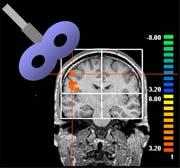 This fMRI highlights regions of the brain that control finger sensation© Hubert Dinse
This fMRI highlights regions of the brain that control finger sensation© Hubert DinsePatients who suffer a stroke could get their movement and feeling back with the helping hand of magnetic pulses fired at their brains, according to new research.
The experimental technique, called repetitive transcranial magnetic stimulation (rTMS), involves placing an electromagnetic coil above the scalp and releasing magnetic pulses that pass through the skull. The alternating magnetic fields cause ionic compounds inside nerve cells to flow, affecting brain activity.
Over the past decade, this procedure has been used in everything from helping with brain imaging studies to treating depression, sometimes by apparently suppressing brain activity. But its full effects still aren't understood.
Hubert Dinse of the Ruhr University in Bochum, Germany and his colleagues were investigating the effects of rTMS on motor activity. Experts had previously shown that magnetic pulses aimed at particular parts of the brain can cause certain muscle groups, such as those in the hand, to twitch. So Dinse and colleagues used very strong, single magnetic pulses to try and locate the motor region of the brain associated with the right index finger in 33 healthy participants.
ADVERTISEMENT
All a tingle
The team knew that they had succeeded in finding a promising spot when a participant's finger began moving involuntarily. The researchers then exposed this area of the brain to magnetic pulses at five hertz, a frequency thought to excite brain cells, for roughly eight minutes. Some taking part said this caused their heads to tingle.
Following this stimulation, the researchers tested the volunteers' sensitivity by placing a pair of pins on the affected finger. Before receiving rTMS, the minimum distance between pins at which patients could feel two distinctive pricks was on average 1.5 millimetres. After stimulation, this distance decreased to 1.3 millimetres, they report in PLoS Biology1.
"That is a very big improvement," says Dinse. "It's basically comparable to the improvement in tactile sensitivity that Braille readers and musicians achieve with training."
Brain scans revealed that the rTMS had increased activity in the targeted region of the brain. But Dinse notes that they don't really understand exactly how this leads to increased sensitivity.
Even without understanding the mechanism, the idea could be useful for stroke patients, Dinse says. Others agree: "From a treatment point of view it's certainly hopeful," says Charles Epstein, a neurologist at the the Emory University School of Medicine in Atlanta, Georgia, who studies the effects of rTMS.
